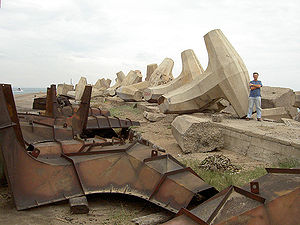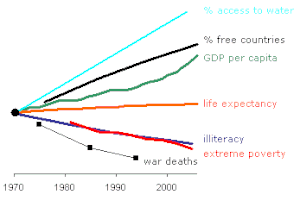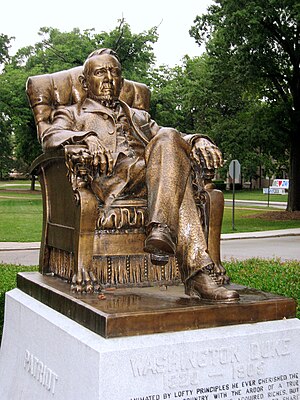 Image via Wikipedia
Image via Wikipedia
Weather History: June 24: Record Temps, Storms, Tornadoes, Wind, Flooding & Snow
Meteorological events that happened on June 24th:
1816
- The cold weather of early June finally gave way to several days of 90 degree heat in Massachusetts, including a reading of 99° at Salem. This is a brief respite from “The Year Without a Summer”.
1904
- A tornado hit the Karacharov Village area in Moscow, Russia killing 24 people.
1929
- A hailstorm at Durban, South Africa, produced hail the size of baseballs. The noise produced by the storm was described as sounding like "machine gun fire".
1946
- 11.72 inches of rain fell at Mellen, WI during a 24 hour period. This is the greatest 24-hour precipitation total ever recorded in the state. There was flooding on the Bad and White Rivers.
1951
- 12 inches of hail broke windows, roofs, and dented automobiles, causing more than $14 million dollars damage at Wichita, KS. The storm plowed 200 miles from Kingmand County Kansas into Missouri, with the Wichita area hardest hit. It was the most disastrous hailstorm on record for the state of Kansas.
1952
- Thunderstorms produced a swath of hail 60 miles long and 3.5 miles wide through parts of Hand, Beadle, Kingsbury, Miner and Jerauld counties in South Dakota. Poultry and livestock were killed, and many people were injured.
1954
- Hurricane Alice formed in the northern Bay of Campeche and moved northwest making landfall on the 25th and flooded the Lower Rio Grande Valley of Texas with up to 27 inches of rain. The U.S. 90 roadway was 30 feet below high water.
1957
- On the basis of meteorological data and a radio report from a shrimp boat, the Weather Bureau in New Orleans issued the first advisory on a tropical depression in the Bay of Campeche at 10:30pm. The depression was located 300 miles south of Brownsville, TX. The storm would become Hurricane Audrey, moving northward over the next three days and striking near the Louisiana/Texas border causing extreme damage and loss of life.
- Palm Springs, CA hit 121°, equaling their highest temperature for June (6/26/1957 & 6/29/1994).
1960
- A tornado at Schenectady, NY destroyed 16 homes with over 300 homes suffering major damage.
1967
- Sheridan, WY fell to 32°, their latest freeze on record; the high temperature the previous day was only 47°.
1972
- A rare eastward moving tornado raced through Maniaki, Quebec Canada. The twister was spawned amid the remnants of Hurricane Agnes.
1975
- An Eastern Airlines Boeing 727 crashed at JFK airport in New York City. 113 of the 124 people on board the aircraft died. Researcher Theodore Fujita studied the incident and discovered that the crash was caused by a microburst. His research lead to improved air safety. The tower never experienced the microburst, which was held back by a seabreeze front. The plane crashed 2,400 feet short of the runway.
1980
- From this date through July 5th, Wichita Falls, TX set record high temperatures each day. Those records have yet to be exceeded. On 11 consecutive days during this period, the temperature rose to at least 110°. Readings exceeded 113° on seven days. During the entire summer, the temperature rose above 100° on 79 days, which is also a record. Heat waves and drought often occur together, and 1980 was no exception. June 1980, with only 0.26 inches of rain, was the driest June since 1933, and the combination of June and July 1980 was the driest June-July period ever recorded in the city.
1987
- Thunderstorms spawned six tornadoes in eastern Colorado. Baseball size hail was reported near Yoder, CO, and thunderstorm winds gusting to 92 mph derailed a train near Pratt, KS. The town of Gould, OK was soaked with nearly an inch and a half of rain in just 10 minutes.
1988
- Many cities reported record high temperatures for the date. Valentine, NE reported an all-time record high of 110°, and highs of 102° at Casper, WY, 103° at Reno, NV, and 106°at Winnemucca, NV were records for the month of June. Highs of 98°at Logan, UT and 109° at Rapid City, SD equaled June records.
- Lightning struck a field at Conway, SC killing 21 cows.
1989
- Thunderstorms developing along a warm front produced severe weather from Colorado and New Mexico to Kansas and Nebraska. Thunderstorms spawned seven tornadoes, and produced wind gusts to 80 mph at Wood River, NE, and hail three inches in diameter at Wheeler, KS.
1991
- 3.50 inches of rain fell in 28 minutes at Scranton, ND. There were also 1.5 foot drifts of marble size hail. Front end loaders were needed to clear the streets.
1992
- A tropical depression in the southeastern Gulf of Mexico produced periods of heavy rainfall over southwest and west central Florida from this date through the 30th. Four-day rainfall totals (25th-28th) of as much as 25 inches were recorded, with 8 to 14 inches common. The heaviest rain fell over Manatee and Sarasota Counties causing widespread river and small stream flooding of homes and roads. 70 homes were destroyed by floodwaters, and the combination of winds, waves and tides led to significant beach erosion and undermining of seawalls in some locations. Two flood-related deaths occurred on the 29th - a man drowned in his flooded front yard in Manatee County and a man was crushed to death between two gasoline storage tanks dislodged by floodwaters at an auto service shop in Charlotte County. All-time record flood crest on the 29th at Myakka St. Park on the Myakka River. Flood waters did not fully recede in some areas until the end of June.
1994
- Australia’s coldest night on record occurred as the town of Charlotte Pass in New South Wales dropped to -9°.
1996
- Severe weather pounded much of the Mid Atlantic Coast with Washington D.C. especially hard hit. Numerous reports of tornadoes, funnel clouds, damaging winds, large hail and heavy rain were reported. Tornadoes were reported in Upperville, Middleburg, Manassas, Centreville and Fairfax City, VA. There were numerous reports of downed trees and damage to structures across Northern Virginia and the Eastern Shore area of Maryland.
1997
- Charleston, WV, finally hit 90° for the first time this year. The last 90-degree day was back on 5/19/1996, totaling 400 days in which it stayed below 90°. That is their longest stretch this century between 90 degree days.
1998
- An unusually damaging wind event occurred during the late night and early morning hours in southwestern Iowa. Winds were sustained at 30-50 mph for over an hour at several locations, including Creston, Shenandoah, Clarinda and Red Oak, IA. Shenandoah, IA reported a gust to 80 mph. Two factors are surmised to have caused the event. First, light showers had moved through the area left lots of hot, dry air aloft between 4,000-10,000 feet. When rain fell through the dry air, it cooled, which made it heavier and resulted in strong downdrafts and high winds. Secondly, winds between 600-5,000 feet were quite strong and the momentum of these winds dropped to the surface causing higher winds. The wind event was accompanied by dramatic rises in temperature.
- The Davis-Beese Nuclear Power plant on the shores of Lake Erie in western Ohio was shut down automatically as a tornado broke power lines. 30 people were injured in the Green Cove Resort area.
2002
- The Missionary Ridge wildfire was visible from downtown Durango, CO as the fire continued to burn out of control northeast of the city. Local residents praying for rain would be rewarded a few days later as monsoonal moisture brought some rain to the parched area. The fire would eventually burn nearly 75,000 acres, making it the second largest wildfire in Colorado history.
2003
- A large F4 tornado destroyed the community of Manchester, SD. It was part of a swarm of nearly 60 tornadoes that touched down across eastern South Dakota. An armored camera placed in the path of the tornado by the National Geographic Society was blown nearly 500 feet and destroyed. Very little usable video was recorded. Meanwhile, researcher Tim Samaras deployed a measurement probe just 70 seconds before the twister struck it. The probe measured a pressure drop of 100 millibars, the largest ever recorded.
- An unusually strong early summer low pressure system in the Rockies dumped up to a foot of wet snow over the western mountains of Wyoming and parts of Yellowstone National Park. The snow fell at elevations above 8,000 feet.
 Image via Wikipedia
Image via Wikipedia






